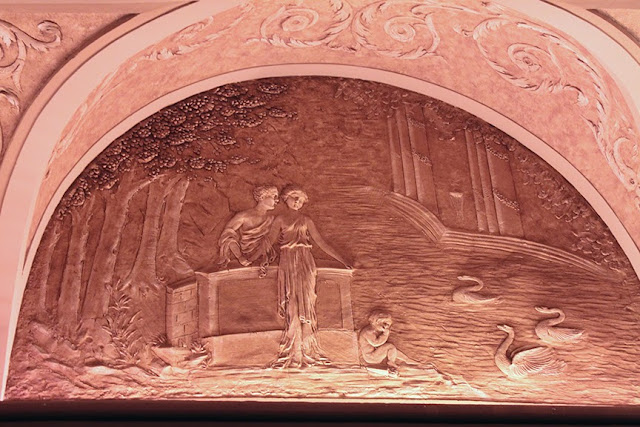 |
| Rialto esplanade, looking towards the rotunda |
Dubbed the ‘Jewel of Joliet’ it is one of the 10 most
beautiful theaters in the country and is on the National Register. Opened in 1926 it was one of the first
theatres to be built to accommodate both vaudeville and movies. In it’s hey day
the theater saw many well known vaudeville performers pass across the stage. The
original Barton Grand Theatre Pipe Organ is still in place, and very much in
use.
 |
| Barton Grande |
As a volunteer usher for about 20 years, I got to see many
wonderful performances. But to me the main performance has always been the
theatre itself. The ‘Jewel of Joliet’ is indeed a rare and sparkling gem. Once,
in my ushering days, someone asked me if it looked better since the
restoration. I’m sure it did, but I answered that it had always looked this
beautiful to me. As I kid I sat in it’s red velvet seats and watched movies,
generally summertime matinees. I have always been in awe of it’s sparkling
crystal chandeliers, mirrored walls and gilt edged sculptures. To walk into
this jewel for the first time is a jaw-dropping experience. To be able to return
again and again is pleasure indeed.
The Rubens Brothers built and designed this theatre to be a
“palace for the people”. Their intent was for the building itself to be part of
the show, for patrons to be transported from the minute they walked through that
front door until they walked out again. C.W. and George Rapp were the
architects, who went on to build other ornate theaters in the Midwest .
The construction firm of Kaiser-Ducett built many of the exhibits at the 1933
Chicago World’s Fair.
 |
| Even the exterior is a work of art - detail of the inlaid tiles in the alcove above the marquee |
Together they created a masterpiece with design elements
reminiscent of the Hall of Mirrors in Versailles ,
France , the Arch de Triomphe
in Paris , and the Pantheon, in Rome
 |
| Chandeliers and reflections of chandeliers in the Rialto's own 'hall of mirrors' |
 |
| Sculptures surrounding the dome of the rotunda |
 |
| This sculpture is repeated on the underside of the balcony so patrons sitting there would not have a blank ceiling to look at |
There are over 100 crystal chandeliers and light fixtures
throughout the Rialto
 |
| Meet The Duchess |
Being in the theatre for any show is exciting, but going
through on one of the guided tours is special. That is when one is able to see
and truly admire the details, unobstructed by other patrons, and hear stories
of it’s rich past and anecdotes about performers who have appeared there. There
is even said to be a ghost or two.
Tours take you through the main areas and also on the stage
where you get the view that the performers get. Many a major star has been
awestruck at the view from the stage – they just don’t build them like that
anymore. As Liberace said – “Finally. A theatre to match my wardrobe!”
 |
| View from the stage - main floor, balcony, and the dome |
 |
| Detail in the dome |
Tours also take you backstage, to the performer's dressing
rooms, the star's dressing room and the ‘green room’, where the walls are
covered with signatures of stars who passed through, waiting for their turn to
be called onstage.
 |
| Autographs! |
Heading back out of the theatre I’m never in a hurry to
leave those marble floors. I take a last look at the Duchess, another glance up
the grand staircase, admire one more sculpture, and bask just a few minutes
more in this atmosphere of grace and elegance.
For more on the Rialto, upcoming events and tours go to http://www.rialtosquare.com/history.asp
and also http://www.cityofjoliet.com/business/rialto.htm
As always, words and photos are my own, and require permission to reprint.
However, feel free to share the blog in it's entirety. In fact, I encourage it!
Interested in photo prints? Contact me! maureenblevins@yahoo.com
See more photos at http://fineartamerica.com/profiles/1-mauverneen-blevins.html
and visit my website: http://mauverneen.com
No comments:
Post a Comment